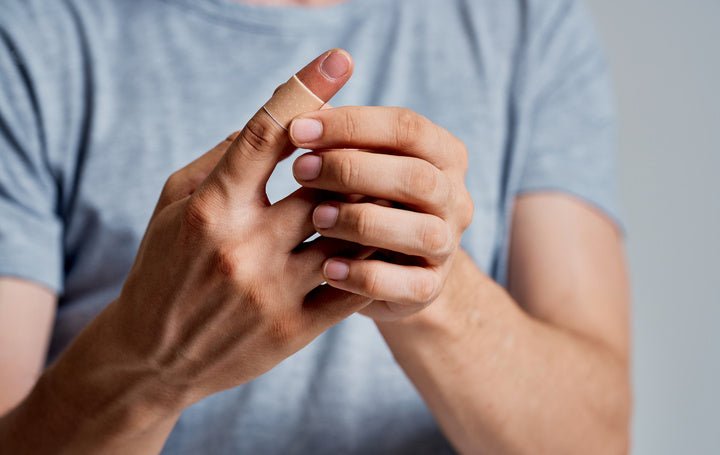Think back to high school: Do you remember your science teacher droning on and on about the layers and functions of the skin and cells? While that info likely didn’t piggyback into adulthood with you, skin science is vital to maintaining strong, healthy skin. Before you see the word science and run for the hills – stick around; your skin is how the world sees you, so learning about its intricacies (AKA skin cells) is how you keep it in tip-top shape.
Since reliving your high school science class is out of the cards, we’ve compiled a guide to the layers and functions of the skin. Here’s a look:
About the Layers and Functions of the Skin: How Many Skin Layers Are There?

Pictured: Close-Up of Your Skin’s Layers | Source: Science Photo
Have you ever wondered about the layers and functions of the skin? Judging from your outside appearance, you’d probably never guess that it's composed of three layers: the epidermis, dermis, and hypodermis. Each of these layers has a unique structure and function that’s key to your skin’s health and appearance:

Pictured: Diagram of Skin Layers and Functions | Source: Very Well Health
The 3 Layers of Skin in Order
The Epidermis
The outermost layer of your skin is called the epidermis. It’s a thin, protective layer that acts as a barrier against environmental stressors (like UV radiation and pollution) while making new skin cells. Interestingly enough, it’s also waterproof and gives your skin its tone.
You shed around 500 million skin cells daily. In fact, the epidermis consists of 20 to 30 layers of dead cells. It works to replenish these cells over the course of four weeks by replacing the dead ones with new cells that can help the epidermis work correctly.
A thin sheet of fibers known as the basement membrane divides the epidermis and the dermis. The basement membrane is a thin layer of extracellular matrix (aids in cell growth) that provides the supporting structure for your skin.
The Dermis
The dermis layer of skin is in the middle. It’s made up of connective tissue, nerves, glands, and blood vessels. As your body’s protector from stress and strain, the dermis also gives your skin strength and elasticity, which is needed for a healthy, young-looking appearance.
Your dermis has three main roles: to make sweat and oil, to provide sensation and blood to the skin, and to grow hair. The dermis can do these things because it houses hair follicles and lymphatic vessels: thin tubes that carry fluid and white blood cells through your body.
In addition, your dermis contains the receptors that detect pain (nociceptors), heat (thermoreceptors), and pressure (mechanoreceptors). If your dermis stretches (maybe from bulking up in the gym) then it can tear, resulting in stretch marks.
While the dermis makes up 90% of your skin’s thickness, its further split into two layers:
- The Papillary Region contains loose tissue that has finger-like projections that push into the top layer of your skin. These projections are responsible for the patterns of your fingertips.
- The Reticular Region contains tissue and protein fibers that give the skin its strength. You can also find hair follicles, sweat glands, and other structures in this region.
The Hypodermis
The hypodermis – sometimes referred to as the subcutaneous layer – is the deepest layer of your skin and is composed of adipose tissue (fat) and connective tissue. It cushions and insulates your muscles and bones, helping to regulate your body temperature.
In the hypodermis, you can find nerves and blood vessels, which get larger as they descend deeper into your skin. These nerves and blood vessels branch out to connect the hypodermis to the rest of your body.
Breaking Down the Layers and Functions of the Skin

Pictured: The Six Vital Functions of Your Skin | Source: Glowsthetics
Your skin is a literal hoss when it comes to keeping your health in check as it has you and your body covered from all angles. Some of the many roles of the layers and functions of the skin include:
- Protection: One of the primary functions of your skin is to protect your body from outside damage (think physical trauma, harmful chemicals, or infectious agents). Your skin's outer layer, the epidermis, acts as a barrier to prevent these things from pushing deeper into your body.
- Temperature Regulation: Your skin plays a key role in controlling your body temperature. When your body gets too warm, for example, your blood vessels dilate and sweat glands leak to give your body a cooldown.
- Sensation: Your skin is full of nerve endings that help you to feel different sensations such as touch, pressure, temperature, and pain.
- Vitamin D Synthesis: When exposed to sunlight, your skin can produce vitamin D, which is important for things like bone health.
- Immune Defense: Your skin keeps you healthy by preventing pathogens (organisms that cause disease) from entering your body.
- Absorption: Certain substances can be absorbed through your skin topically, including medications and nutrition like vitamin C.
- Appearance: Your skin is an important part of your appearance, and – according to research – can influence your self-confidence and social interactions. Skin health can be affected by factors such as genetics, diet, and lifestyle choices.
Skin Cells: Types and Function

Pictured: Types of Cells in Your Body | Source: Thought Co.
Did You Know? You have around 300 million skin cells. A single square inch of your skin has nearly 19 million cells and up to 300 sweat glands. Plus, your skin is its thickest on your feet (1.4mm) and thinnest on your eyelids (0.2mm). Your skin also renews itself every 28 days. Cool as hell, right?
If you’re new to skin cells and what their functions are, let me back up: Skin cells are the basic building blocks of your skin. The most well-known skin cell is called the keratinocyte, which creates a tough, waterproof layer over your skin to protect it from things like UV rays and pathogens.
Some skin cell types to keep in mind are:




About the Layers and Functions of the Skin: What Do Skin Cells Look Like?

Pictured: Squamous Skin Cells: Flat, Keratinized, Dead Cells That Are Continuously Sloughed off and Replaced With New Cells | Source: Thought Co.

Pictured: Psoriasis Skin Cells | Source: Science Photo

Pictured: Keratinocyte Skin Cell | Source: Science Photo
Skincare That Works in Conjunction With the Layers and Functions of the Skin: Grab the MOX Daily Face Care Kit Today

The MOX Peppermint Cleanser and Multi Nutrient Serum – now being sold as the Daily Face Care Kit – are two powerful products that work together with the layers and functions of the skin on a cellular level.
MOX formulations do this by penetrating through the dermal layer of your skin to the living cells deep within, which is something not all skincare products are able to do. MOX products can reach your cells through three different strategies:
- MOX piggybacks vitamins onto other ingredients similar to your skin in order to reach your skin’s barrier. Due to this, the products can flood your skin cells with vitamins so they produce more of the good stuff like collagen.
- MOX uses ingredients that are found in your skin naturally such as squalane. This allows MOX formulations to take advantage of the chemistry already happening in your skin by supporting its anti-aging and healing systems.
- MOX chooses fatty ingredients – like lipids – that can pass through your skin’s raincoat-like barrier.

Try the Daily Face Care Kit today and see the difference in your cells. And tell us -- were you familiar with the layers and functions of the skin?
References:
- https://my.clevelandclinic.org/health/articles/10978-skin
- https://www.medicalnewstoday.com/articles/320435#functions
- https://www.news-medical.net/health/What-is-the-Epidermis.aspx
- https://www.ncbi.nlm.nih.gov/books/NBK10965/
- https://www.ncbi.nlm.nih.gov/books/NBK470464/
- https://onlinelibrary.wiley.com/doi/full/10.1111/exd.12832




Leave a comment
This site is protected by hCaptcha and the hCaptcha Privacy Policy and Terms of Service apply.